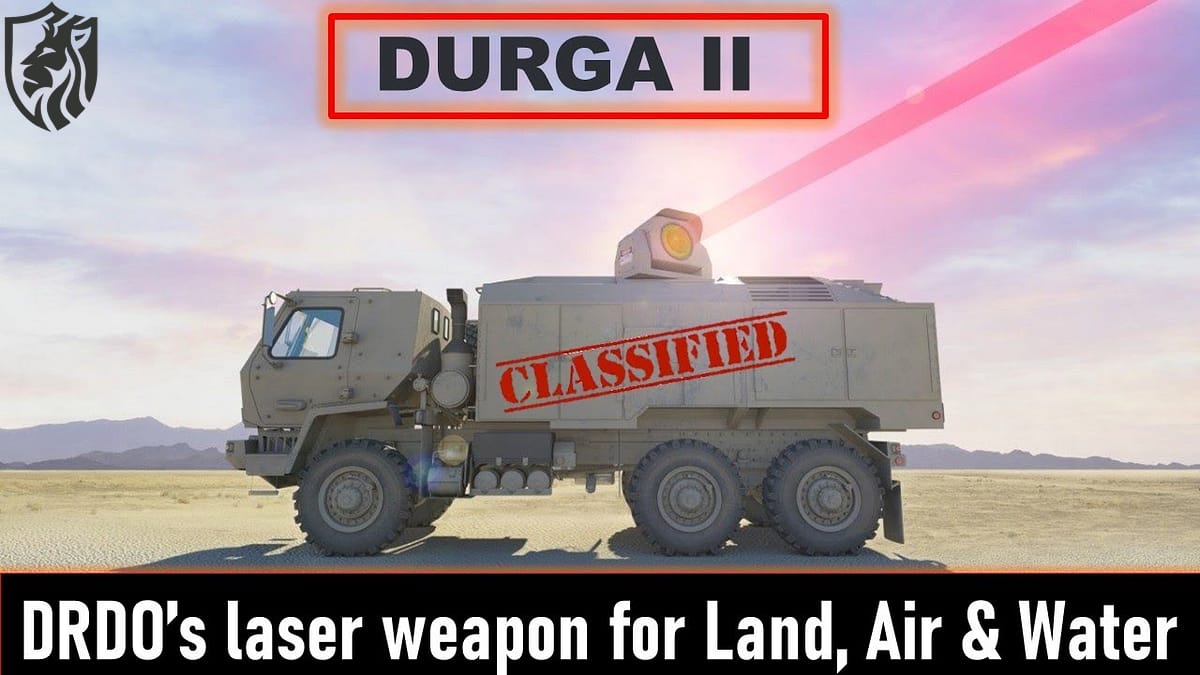
Durga 2
In the evolving landscape of military technology, countries are racing to develop advanced systems capable of countering aerial threats. Among these developments is DURGA 2: India’s Very Own Laser Weapon. As nations strive to create robust anti-missile and anti-drone systems, India’s Defence Research and Development Organisation (DRDO) has made major improvements to laser weaponry over the past two decades.

The Race for Laser Weapon Technology
Military powers, from the United States to Turkey, are intensifying efforts to implement next-generation laser weapon systems. These systems can neutralise missiles, fighter aircraft, and drones, making our skies safer.
While India has been relatively quiet about its DURGA 2: India’s Very Own Laser Weapon, discussions in strategic circles indicate that testing of this prototype has reached advanced stages. By focusing energy in a highly concentrated manner, directed energy weapons can disable threats from the sky, thereby protecting vital infrastructure from missile and aerial assaults.
Understanding Directed Energy Weapons
DURGA 2: India’s Very Own Laser Weapon operates as a direct energy weapon, utilising laser technology to damage or destroy targets. It can act quickly—travelling at the speed of light—to neutralise threats before they reach their targets.
TThis capability positions DURGA 2, India’s own laser weapon, as a potentially transformative weapon in modern warfare. Traditional anti-aircraft systems may falter, but laser weapons promise a 100% kill probability, providing unprecedented defences against airborne threats.
India’s Strategic Needs
DURGA 2: India’s very own laser weapon emerges in response to the evolving missile capabilities of neighbouring countries, particularly China and Pakistan. While India has invested heavily in the S-400 anti-missile systems from Russia, these systems cannot guarantee the destruction of every incoming missile. The laser weapon offers a more effective approach, potentially neutralising not just missiles but also enemy radars and electronic warfare systems.
This capability could render enemy missile installations ineffective, enhancing India’s defensive posture in a volatile region. The implications of DURGA 2, India’s Very Own Laser Weapon, are profound, offering India a strategic edge.
Progress and Development of DURGA 2
The Laser Science and Technology Centre (LSTC) in New Delhi is at the forefront of developing DURGA 2: India’s Very Own Laser Weapon. This facility is enhancing various laser generation techniques, including solid-state, fibre, and chemical lasers. Reports indicate that the LSTC has successfully developed a 25 kW laser capable of targeting ballistic missiles up to 5 km away. Experts are now working to extend this range to 100 km or more.
In 2017, the DRDO tested a 1 kW laser mounted on a truck, which successfully hit targets at a distance of 250 metres. Despite these advancements, one of the significant challenges remains supplying adequate power for high-energy laser systems. However, the ongoing work at LSTC reflects India’s commitment to making DURGA 2: India’s Very Own Laser Weapon a reality.
The Israeli Connection: Iron Beam
Interestingly, more people are now talking about Israel’s Iron Beam system. It works in a way similar to India’s DURGA 2 laser weapon. Israel designed Iron Beam to intercept threats using laser technology. The demonstration shows how effective such systems can be in modern warfare. The similarities between Iron Beam and DURGA 2 are striking. They highlight a global shift towards using directed energy weapons for aerial defence.

As India’s focus on DURGA 2: India’s Very Own Laser Weapon intensifies, Pakistan is also moving to acquire the LW-30 laser defence weapon system from China. This development mirrors India’s acquisition strategy, where they have benefited from Israeli advancements.
Pakistan’s pursuit of such systems reflects a broader trend among regional militaries seeking to enhance their air defence capabilities, especially in light of the potential threats posed by Indian laser weapons.
Global Context of Laser Weapons
The US has already deployed targeted energy weapons for drone defence. These systems, which use lasers to disable drone components, demonstrate the efficiency of such technologies. With plans to upgrade to a 500 kW laser, Lockheed Martin’s 300 kW laser is currently in operation. Lockheed Martin anticipates strong demand from the US military as they develop laser systems because of their low operating costs.
By contrast, deploying conventional missile systems for air defence is significantly pricier, each requiring between $50,000 and $150,000 in operating expenses. On the other hand, a laser gun can only cost a few dollars per shot. This potential is demonstrated by Israel’s Iron Beam, the first energy-based weapon system in the world, which can intercept mortars, rockets, and UAVs for just $3.50 each.
The Future of Warfare
As militaries worldwide shift their focus towards cost-effective solutions, India’s DURGA 2, a laser weapon of its own, strategically positions India in the race for military superiority. This indigenous laser weapon system could be an effective and affordable alternative to traditional ballistic missile defence systems, such as Russia’s S400 and the USA’s Patriot.

Indian strategic circles eagerly await DURGA 2, India’s Very Own Laser Weapon, with its potential to effectively tackle aerial threats. As research progresses, the hope is that this game-changing technology will bolster India’s national security and redefine its military capabilities.
Conclusion
In conclusion, the development of DURGA II—India’s very own laser weapon—represents a significant leap in India’s defence technology. India intends to defend its airspace from changing threats by investing in cutting-edge laser systems. As more countries embrace laser technology, India’s efforts could reshape battlefield dynamics. DURGA 2 may soon become a crucial part of India’s military strategy.
References
- US Defence News, 2021
- Lockheed Martin, 2024
- Israeli Defence Forces, 2024






